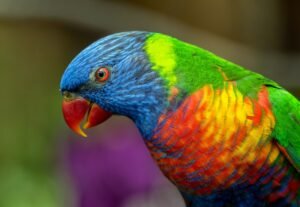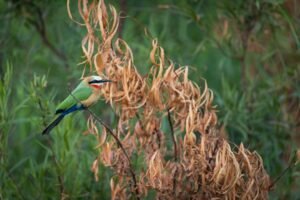Sun Parakeets (Aratinga solstitialis), also known as Sun Conures, are vibrant parrots native to northeastern South America. They are members of the Psittacidae family and are renowned for their striking yellow, orange, and red plumage. In their natural habitat, Sun Parakeets are highly social birds, forming strong bonds within their flocks and often flying in large groups.
These parrots are known for their intelligence, curiosity, and acrobatic abilities. They frequently engage in playful behaviors, such as hanging upside down from branches and interacting with flock members. Sun Parakeets communicate through loud, distinctive vocalizations, which serve to maintain contact within the group and establish their presence in the wild.
Sun Parakeets have become popular as pets due to their friendly nature and capacity for mimicking human speech. Their vibrant coloration and energetic personalities make them attractive to avian enthusiasts and pet owners. However, it is important to note that these birds require specialized care, attention, and a suitable environment to thrive in captivity.
In their natural habitat, Sun Parakeets contribute to the biodiversity of South American ecosystems. Their presence adds a colorful element to the region’s lush green landscapes. Unfortunately, wild populations of Sun Parakeets have declined due to habitat loss and capture for the pet trade, leading to conservation concerns for this species.
Key Takeaways
- Sun Parakeets are colorful and social birds native to South America, known for their vibrant plumage and playful nature.
- They have a striking appearance with bright yellow and orange feathers, and are medium-sized parrots with a gentle disposition.
- Sun Parakeets are found in the tropical rainforests and woodlands of northeastern South America, particularly in Guyana, Brazil, and Suriname.
- They are highly social birds that form large flocks and communicate through loud calls and vocalizations.
- Sun Parakeets primarily feed on a diet of fruits, seeds, nuts, and berries, and are known to forage in groups for food.
Physical Characteristics of Sun Parakeets
Physical Characteristics
Sun Parakeets are small to medium-sized parrots, measuring around 12 inches (30 cm) in length from head to tail. They have a stocky build and a short, square-shaped tail. Their most striking feature is their vibrant plumage, which consists of bright yellow feathers on the body, orange patches on the wings, and a splash of red on the forehead, lower belly, and tail.
Wings and Beak
Their wings are long and pointed, allowing them to fly swiftly and maneuver through the dense foliage of their natural habitat. Sun Parakeets have a strong, hooked beak that they use for cracking open seeds and nuts, as well as for climbing and exploring their environment.
Feet and Eyes
Their feet are zygodactylous, meaning they have two toes facing forward and two toes facing backward, which gives them a strong grip and allows them to perch securely on branches and tree limbs. Sun Parakeets have a white ring around their eyes, which adds to their striking appearance. Their eyes are dark brown and are surrounded by bare patches of skin that can change color depending on their mood. When excited or agitated, the bare patches around their eyes can turn a bright pink or red color, adding to their expressive nature.
Overall Appearance
Overall, Sun Parakeets are visually stunning birds with a combination of colors that make them stand out in any setting.
Habitat and Distribution of Sun Parakeets

Sun Parakeets are native to the northeastern regions of South America, including parts of Brazil, Guyana, Suriname, and French Guiana. They inhabit a variety of forested habitats, including tropical rainforests, savannas, and woodland areas. Sun Parakeets are highly adaptable birds and can be found in both primary and secondary forests, as well as in agricultural areas with scattered trees.
They are known for their acrobatic flying abilities and can often be seen darting through the treetops in search of food or flying in large flocks across the sky. In the wild, Sun Parakeets form large flocks consisting of dozens or even hundreds of individuals. They are social birds that rely on the safety and companionship of their flock members for survival.
Their vibrant plumage allows them to blend in with the colorful foliage of their natural habitat, making them well-camouflaged from predators such as hawks and snakes. Sun Parakeets are also known for their adaptability to human-altered landscapes and can be found in urban areas where they feed on fruit trees and visit bird feeders. Despite their adaptability, Sun Parakeets face threats from habitat loss due to deforestation and illegal trapping for the pet trade.
Behavior and Social Structure of Sun Parakeets
| Behavior and Social Structure of Sun Parakeets | |
|---|---|
| Species | Aratinga solstitialis |
| Group Name | Flock |
| Communication | Vocalizations, body language |
| Feeding Behavior | Seed eaters, fruits, and vegetables |
| Reproduction | Monogamous, nesting in tree cavities |
Sun Parakeets are highly social birds that form strong bonds with their flock members. They are often seen flying in large flocks consisting of dozens or even hundreds of individuals, creating a spectacular display of color as they soar through the sky. Within these flocks, Sun Parakeets engage in playful interactions, such as chasing each other through the treetops or engaging in acrobatic flight displays.
They use vocalizations to communicate with each other, including loud calls that can be heard from a distance. In addition to their social nature, Sun Parakeets are also known for their playful behavior. They are curious birds that enjoy exploring their environment and engaging in acrobatic feats such as hanging upside down from branches or swinging from tree limbs.
They are also known for their ability to mimic sounds and human speech, making them popular pets among bird enthusiasts. In the wild, Sun Parakeets rely on their flock members for safety and companionship, and they work together to find food, build nests, and raise their young. Their social structure is an important aspect of their survival in the wild and contributes to the overall success of their species.
Diet and Feeding Habits of Sun Parakeets
Sun Parakeets are primarily frugivorous, meaning they feed on a diet consisting mainly of fruits and berries. In the wild, they forage for a variety of fruits such as mangoes, papayas, guavas, and figs, as well as seeds, nuts, and flowers. They use their strong beaks to crack open hard-shelled seeds and nuts, extracting the nutritious contents inside.
Sun Parakeets are also known to feed on agricultural crops such as corn and rice, which can bring them into conflict with farmers in some areas. In addition to fruits and seeds, Sun Parakeets also consume insects as a source of protein. They may pick insects off leaves or catch them in mid-air while flying.
In captivity, Sun Parakeets require a balanced diet consisting of high-quality pellets, fresh fruits and vegetables, and occasional treats such as nuts or seeds. It is important for pet owners to provide a varied diet to ensure that their Sun Parakeet receives all the necessary nutrients for optimal health. Overall, Sun Parakeets are opportunistic feeders that take advantage of a wide range of food sources in their natural habitat.
Breeding and Reproduction of Sun Parakeets

Courtship and Pair Bonding
To attract a mate, Sun Parakeets engage in elaborate courtship displays, which include mutual preening, feeding each other, and vocalizations to reinforce their bond.
Nesting and Incubation
Once a pair has formed, they will search for a suitable nesting site in a tree cavity or hollow branch. Both male and female Sun Parakeets take part in excavating the nest cavity by chewing away at the wood with their strong beaks. The female will lay a clutch of 3-5 eggs, which she will incubate for about 23 days while the male brings her food.
Raising the Chicks
Once the eggs hatch, both parents take turns feeding and caring for the chicks until they fledge at around 7-8 weeks old. The young birds will remain with their parents for several more weeks as they learn essential skills such as foraging for food and avoiding predators.
Conservation Status and Threats to Sun Parakeets
Sun Parakeets are listed as “Endangered” on the IUCN Red List due to habitat loss and illegal trapping for the pet trade. Deforestation in their native range has resulted in the loss of critical nesting sites and food sources for these birds. Additionally, trapping for the pet trade has significantly reduced wild populations of Sun Parakeets, as they are highly sought after for their striking plumage and playful personalities.
Conservation efforts are underway to protect the remaining populations of Sun Parakeets in the wild. These efforts include habitat restoration projects, education programs to raise awareness about the illegal pet trade, and captive breeding programs aimed at reintroducing birds into suitable habitats. It is crucial for these conservation efforts to continue in order to ensure the long-term survival of this beautiful species.
In conclusion, Sun Parakeets are captivating birds with their vibrant plumage, playful behavior, and social nature. They play an important role in their native ecosystems as seed dispersers and contribute to the overall biodiversity of South American forests. It is essential for us to work together to protect these magnificent birds and ensure that future generations have the opportunity to admire them in their natural habitat.
By raising awareness about the threats they face and supporting conservation initiatives, we can help secure a brighter future for Sun Parakeets in the wild.
The vibrant colors of the sun parakeets are truly a sight to behold, and their beauty is just one of the many reasons why they are a popular choice for bird enthusiasts. In a related article, Justine Triet reflects on historic Oscar nomination for Anatomy of a Fall, the director discusses the significance of her film’s recognition by the Academy. Just as the sun parakeets stand out with their stunning plumage, Triet’s film has made a lasting impression in the world of cinema.
FAQs
What is a sun parakeet?
A sun parakeet, also known as the sun conure, is a small and colorful parrot species native to northeastern South America.
What do sun parakeets look like?
Sun parakeets are known for their vibrant yellow and orange plumage, with green and blue accents on their wings and tail. They have a distinctive black beak and white eye rings.
What do sun parakeets eat?
In the wild, sun parakeets primarily feed on fruits, seeds, and nuts. In captivity, they can be fed a diet of high-quality parrot pellets, fresh fruits, and vegetables.
Are sun parakeets good pets?
Sun parakeets are popular pets due to their striking appearance and playful nature. They are known for their social and affectionate behavior, but they require a lot of attention and interaction from their owners.
How long do sun parakeets live?
In captivity, sun parakeets can live for up to 20 years with proper care and attention to their diet and environment.
Are sun parakeets endangered?
Sun parakeets are listed as endangered in the wild due to habitat loss and trapping for the pet trade. Conservation efforts are in place to protect their natural habitats and regulate their trade.




















+ There are no comments
Add yours